Advantages of Using Platforms vs. Apps in Collaboration Software
When considering the implementation of team collaboration software, an often overlooked distinction is the one that exists between a vertical specialized “app” and a horizontal, versatile and less specialized “platform”.
A software platform is defined as “a major piece of software, as an operating system, an operating environment […] under which various smaller application programs can be designed to run.” A platform therefore is a set of apps running inside one digital framework and user experience and is typically modular and extensible by design.

Content
You can think of something like Slack, a team chat tool, as one example of a collaborative application versus something like eXo Platform where chat is one of several collaborative apps integrated inside a broader collaborative digital workplace software.
Which one is more appropriate for your organization depends on your goals for adopting digital collaboration in the first place. Below are some reasons why we feel platforms are a better investment.
1. Ability to better accommodate corporate-level communications and communication strategies
Digital collaboration platforms are all-in-one solutions able to act as an organization’s corporate intranet or extranet. As such, they often come equipped with a content management system of sorts allowing internal communication professionals to create and publish top-down communications as well as social engagement tools for overcoming communication silos and improving employee engagement.
A specialized collaborative app such as a instant messaging, document management or project management system is not usually meant to double as a communications portal implemented at a strategic corporate level.
Digital workplace platforms are also often used as the organization’s centralized entry point for employees to access digital work tools. They are therefore better for targeting larger audiences with key communications compared to specialized collaboration apps.
2. Ability to act as the true backbone for your digital workplace
An organization’s collaborative intranet today is often implemented with the type of goals in mind such as aligning the workforce and improving the organization’s knowledge management. When this is the case, the intranet is expected to act as a true unified collaborative hub for the organization.
By design, a horizontal platform solution that promotes interoperability is more able to achieve this in a sensible way compared to a vertical software. It should be able to:
- Federate role-based access to business apps for employees.
- Aggregate, filter and contextualize key information streams from different business apps.
- Introduce a broader collaborative dimension to business tools that may lack it or benefit from it. (See this CRM integration example.)
This gives extensible intranet platform solutions the advantage over vertical collaboration apps in the context of implementing an actual organization-wide unified digital collaboration hub.
Granted, this will not stop certain specialized collaboration tools such as Slack (a chat tool that is more adapted for smaller teams) from trying to play that role by providing a large ecosystem of integrations. But the truth remains that something like Slack is in its DNA a chat tool. And whether you can truly build an organization-wide integrated digital workplace merely around chat threads while managing to solve all the associated knowledge management issues should be seriously questioned. This is because something like chat is a piece of the collaboration puzzle and not its backbone. So trying to force the streamlining of all possible collaborative and knowledge management scenarios around chat feeds is a challenge in itself.

FREE WHITE PAPER
Types of Digital workplace solutions
The modern workplace has evolved significantly in recent years, with advancements in technology, the growing number of tools …
3. Ability to accommodate additional future use cases within the same platform
Examples of this are extending the organization’s internal digital workplace portal to accommodate external-facing communities.
Future needs may arise where the organization may see value in using its existing collaborative intranet system to collaborate with non-employee populations such as customers and/or partners through dedicated and integrated environments. Advantages of this include:
- Providing a unified user experience for your staff in terms of their internal vs. external collaborative use cases.
- The ability to implement easier ways for staff to access and share information stored in their digital workplace with these external populations when supporting them and collaborating with them within the same digital environment,
- Enabling selective integration to the proper business apps and their associated signal flows used when serving these external members.
4. Large scale implementation and adoption
Specialized collaboration apps are typically easier and quicker to implement and adopt at lower scale, such as within individual teams or business units. However, they are also typically more difficult to scale to several or all departments due to their inherent specialization and lack of personalization to meet the needs of different teams and diverging user personas within one system.
A platform’s flexibility advantage goes both ways though. You can still start small with if you wish so thanks to its modularity. This is especially the case today where the implementation of platform’s is simple through things like native enterprise readiness, native mobile readiness and cloud hosting.
In other words, you can make a platform into a specialized app, but you cannot make an app into a broader collaboration hub.
So if large scale adoption of the collaborative system is a current or future objective within your organization, then it is better to invest in gradually building and rolling out your tailored digital workplace experience according to a proper user adoption strategy.
5. Flexibility with the deployment model and software transparency
Feeding back into the above question of higher scalability (technical and usage/adoption wise), collaboration apps are almost always exclusively offered as a closed-source SaaS offering.
While this varies from one software vendor to another, platforms on the other hand more commonly still offer more deployment models such as on-premise hosting. This allows IT leaders especially in security-sensitive and heavily regulated contexts to maintain control on their data and implementation by keeping everything in their private infrastructure.
Similarly, platform solutions are more likely to offer higher transparency through things like open source software and open interoperability standards. This also has positive implications on data privacy along with other benefits related to things like long-term cost control and policy and technical flexibility considerations.
FAQ
You will find here Frequently Asked Questions about collaboration with all the answers in one place.
What is collaboration?
Collaboration is “the situation of two or more people working together to create or achieve the same thing”.
What are the different types of collaboration in business?
Here are some definitions of digital workplace:
- Team collaboration
- Cross-departmental and interdisciplinary collaboration
- Community collaboration
- Strategic partnerships and alliances
- Supply chain collaboration
How to choose the best type of collaboration?
In order to effectively find the right type of collaboration for your business, you have to follow a strategic approach and answer three common yet critical questions: Where are we? Where do we want to be? And how to get there?
Why collaboration is important?
At the internal level, businesses try to encourage and seek to incorporate different forms of collaboration in the workplace to lay the foundations for teams to be able to work together with an aim to achieve higher levels of success.
Externally, businesses look to engage in collaborative actions to benefit from others’ expertise, to gather the opinions of their customer base and to get customers and other stakeholders more involved in the development of products and services.
What are the benefits of collaboration in the workplace?
Here are some of the benefits of collaboration in the workplace:
- Foster innovation and creativity
- Better problem solving
- Effectively handle times of crises
- Engage and align teams
- Increase motivation
- Attract talents

Related posts
- All
- eXo
- Digital workplace
- Employee engagement
- Open source
- Future of work
- Internal communication
- Collaboration
- News
- intranet
- workplace
- Knowledge management
- Employee experience
- Employee productivity
- onboarding
- Employee recognition
- Change management
- Cartoon
- Digital transformation
- Infographic
- Remote work
- Industry trends
- Product News
- Thought leadership
- Tips & Tricks
- Tutorial
- Uncategorized


